Front
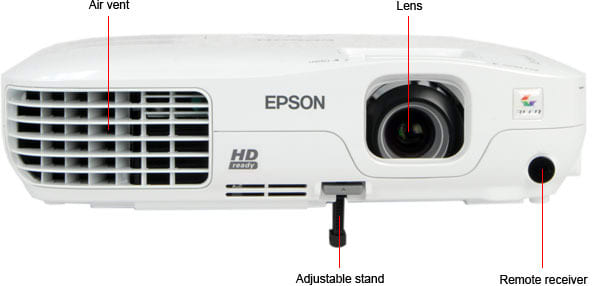
Back
{{section_header}}{{section.name}}{{/section_header}}
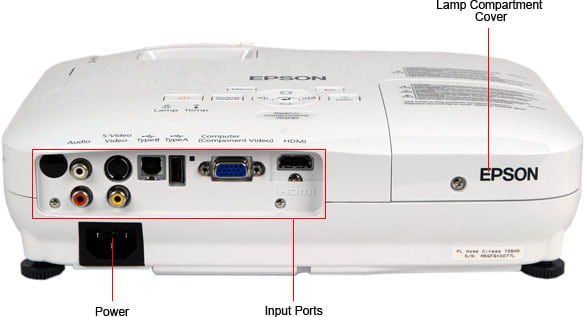
Sides
{{section_header}}{{section.name}}{{/section_header}}
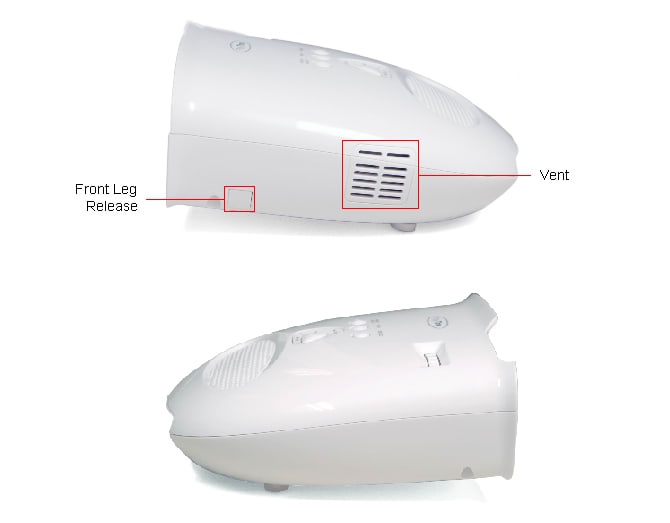
Top/Bottom
{{section_header}}{{section.name}}{{/section_header}}
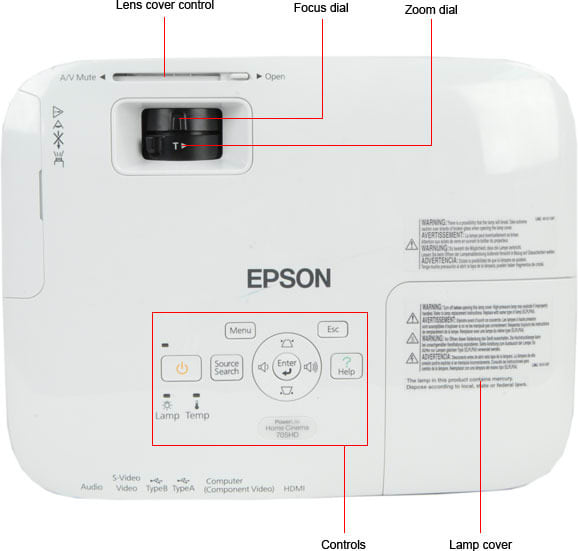
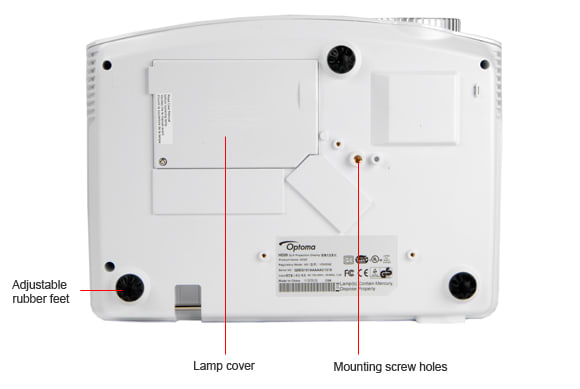
Stand/Mount
{{section_header}}{{section.name}}{{/section_header}}
The bottom of the Optoma GT720 has three adjustable feet on the bottom. However, the lens is pitched at such an angle that you may have to stick random items underneath it to level it out with the projector screen. There are also mounting holes for permanently affixing the GT720 to a surface.
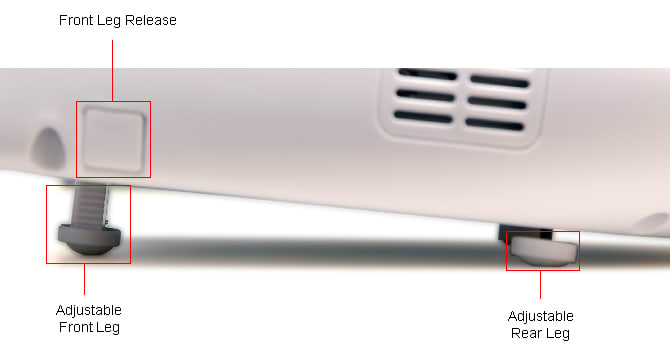
Lamp
Remote Control Tour
{{section_header}}{{section.name}}{{/section_header}}
The remote control that ships with the Optoma GT720 is handy, in theory, but rather awkward in practice, due to confusing button layout. Also, the IR receiver is only on the front of the projector, so you can't stand behind it and operate it remotely.
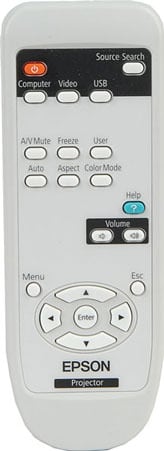
The small remote control of the 705HD
In the Box
{{section_header}}{{section.name}}{{/section_header}}
To really drive home the "portable gaming" message of the Optoma GT720, it ships with this large backpack. Optoma skimped on padding the bag itself, and instead provides a heavy duty, inflated plastic jacket that fits around the projector. Should it pop (which it will, in time), you'll have to get creative about providing your own padding.
The GT720 also ships with a power cable, lens cap, instruction manual and documentation, and a composite-to-VGA adapter.
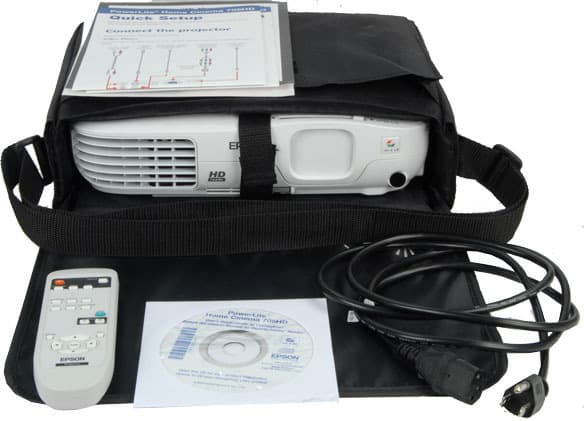
The 705HD comes with a carrying case, manuals, power cable and remote
Portability
{{section_header}}{{section.name}}{{/section_header}}
The Optoma GT720 is clearly designed to be portable, what with the included backpack and all. We've certainly seen smaller projectors, but it makes sense that gamers want the brightness and video quality that ultra-compacts and pico projectors just won't be able to deliver. Measuring 12.76 x 3.82 x 9.21 inches and weighing in at 6.5 lbs, it's portable enough, but expect that you'll pretty weighed down if you have to lug this along with an XBox or PS3, power supplies, and game controllers.
{{product.raw_scores['Portability']}}
Setup Assistance
{{section_header}}{{section.name}}{{/section_header}}
The Optoma GT720 sets up in less than a minute, but like all projectors, will take a while to line up correctly with the screen and manually focus and keystone. There are no auto features for detecting and adjusting to projection surfaces.
{{product.raw_scores['Setup']}}
Aesthetics
{{section_header}}{{section.name}}{{/section_header}}
The Optoma GT720 has a glossy black finish that looks nice out of the box, but quickly picks up fingerprints and minor scratches. We received a slightly older GT720, and you can see in the photos above what happened when the projector had been stored in the included bubble wrap. Those long, thin lines are permanently marred into the surface of the projector.
Peak Brightness
{{section_header}}{{section.name}}{{/section_header}}
The Optoma GT720 can create a very, very bright white. It's unrelated to the short throw, because the values below are in lumens, which measures raw brightness and ignores throw distance as a factor. Clearly, the mode you choose has a huge factor on the brightness. Bright mode is brightest (big surprise). Cinema mode is the dimmest, but we highly recommend it for movies and gaming, because it's the only mode that offers decent color performance.
{{image_chart title="Peak Brightness", attachment="Peak Brightness Graph"}}
The Optoma GT720 has a great peak brightness compared to other projectors. It trumped the three similar projectors that we pulled in for comparison.
{{image_chart title="Peak Brightness", attachment="Peak Brightness Comparison Graph"}}
Tunnel Contrast
{{section_header}}{{section.name}}{{/section_header}}
The Optoma GT720 has a hard time maintaining a consistent black level as the amount of black area on the screen decreases. This is the same kind of problem that we see frequently in plasma TVs. Look at the chart below. The right side represents the black level when 90% of the screen is a black rectangle. The left side is just 5% black, surrounded by 95% bright white. The black level has brightened by several-fold.
{{image_chart title="Tunnel Contrast", attachment="Tunnel Contrast Graph"}}
Uniformity
{{section_header}}{{section.name}}{{/section_header}}
The Optoma GT720 definitely showed some problems with screen uniformity. You can see in the chart below that when we measured the screen brightness at 9 points, there's significant unevenness. The center and top are so much brighter than the bottom and sides.
{{image_chart title="Uniformity", attachment="Uniformity Graph"}}
Greyscale Gamma
{{section_header}}{{section.name}}{{/section_header}}
The Optoma GT720 does a good job of transitioning from black to white, which is called the greyscale gamma. Look at the chart below. The shadows are the left side and the highlights are the right side. The line is smooth as it transitions up and to the right. There's no instance of kinks or areas of flatness that might indicate a lack of detail. Also, consider the slope of the line. An ideal slope is somewhere between 2.1. and 2.2. The Optoma GT720's performance of 2.26 is very nearly on the money, and earned it a good score.
Color Temperature
{{section_header}}{{section.name}}{{/section_header}}
The Optoma GT720 had absolutely no problems with maintaining a consistent color temperature throughout the signal range, from dark to bright.
{{image_chart title="Color Temperature", attachment="Color Temperature Graph"}}
RGB Curves
{{section_header}}{{section.name}}{{/section_header}}
To get a good sense of color performance, we separately test every value of all three color channels: red, green, and blue. The chart below is the aggregate result. The smooth, gradual upswing starting at the lower left indicates that the projector is capable of showing great shadow detail. Granted, the three channels are not moving in perfect unison – the green is significantly brighter than the red – but as they move up towards mid-tones the channels become one line. In the upper mid-tones and into the highlights (right side) the curve steepens, meaning the Optoma GT720 is displaying less detail.
Overall, it's a strong performance.
{{image_chart title="RGB Curves", attachment="RGB Curves Graph"}}
Color Gamut
{{section_header}}{{section.name}}{{/section_header}}
The Optoma GT720 did not match up well with the rec. 709 standard, a common color standard. As you can see in the chart, each of the corners of the triangle – representing the red, green, and blue points – are well off the mark.
{{image_chart title="Color Gamut", attachment="Color Gamut Graph"}}
Motion Smoothness
{{section_header}}{{section.name}}{{/section_header}}
The Optoma GT720 generally produced a very smooth motion performance. Images with fine, complex detail will show break-up more than areas of flat or little detail, as you might expect. Overall, we noticed a slight stutter in moving images, but it wasn't too bad. Strictly speaking about motion smoothness, there was no difference from one resolution to another.
Motion Artifacting
{{section_header}}{{section.name}}{{/section_header}}
Artifacts are anything you see on the screen that weren't in the original signal. Different display technologies all have different artifacts. With the Optoma GT720, we noticed some bad sharpening and color shift around areas of high contrast. The artifacting was more noticeable in the 1080p resolution than in the native resolution.
3:2 Pulldown & 24fps
{{section_header}}{{section.name}}{{/section_header}}
The Optoma GT720 has no specific modes or processing features to aid in the rendering of native 24fps content, but it can display it effectively enough (some projectors can't handle 24fps at all). In testing, we noticed that the GT720 showed some problems with high frequency patterns, and some slight stuttering when the camera pans horizontally. Overall, though, it was rather good.
Resolution Scaling
{{section_header}}{{section.name}}{{/section_header}}
The Optoma GT720 has a native resolution of 1280 x 800 (WXGA), but is technically capable of handling all standard video resolutions. It's up to the projector's internal processing to scale the video signals for display. Overall, it's not very good at this task. This is significant for gaming systems, which are 1080i and 1080p, by and large.
480p
When we fed the Optoma GT720 video in the 480p format, we saw no problems. This was the best of the three resolutions.
720p
With 720p content, the Optoma GT720 showed major problems with high frequency patterns. There was an incredible amount of Moire. Also, fine text was difficult to read.
1080p
With 1080p content, we saw exactly the same problems with Moires in high frequency patterns. However, fine text was easier to read.
3D Readiness
{{section_header}}{{section.name}}{{/section_header}}
We're unclear if the Optoma GT720 supports 3D. DLP is easily fast enough to support the basic technical requirements of 3D, but it's not 3D-ready out of the box. This is the quote directly from the official product page:
"Optoma projectors cannot be used to display 3D TV broadcasts or 3D Blu-ray discs. Optoma projectors may support these applications in the future but will require additional hardware at extra cost" (http://www.optomausa.com/Product_detail.asp?productsubcat=27productcategory=Game+Timeproduct_id=479itemno=EPGT720>read entirety
).
At the very least, you'll need to purchase active shutter glasses, which run up to $150 per pair. But for the glasses to work, you also need a transmitter that sends a sync signal from the projector, and there's no compatible package on the market right now that will work with the Optoma GT720.
Throw
{{section_header}}{{section.name}}{{/section_header}}
The Optoma GT720 has a very short throw and no zoom lens, making it a not-terribly-flexible projector. You need to position it just so in order to fit it correctly to your screen. An 80-inch screen requires a distance of just 67 inches (5 ft, 7 in).
Ignore the second row of values in the chart below. Because there's no zoom lens on the Optoma GT720, the wide angle and telephoto are the same.
Screen Brightness
{{section_header}}{{section.name}}{{/section_header}}
The screen brightness produced by the Optoma GT720 falls off rather quickly as you move the projector further back from the screen. It's the same for any projector, but these numbers in the chart below should give you some idea of whether the Optoma GT720 is right for your particular room layout.
Still not sure whether the Optoma GT720 is right for you? This chart below should simplify it a little.
In an ideal world, projector manufacturers might hope that you do all your movie watching and video game playing in a dark room, where their projectors do the best job. Of course, this is not usually the case. A projector's abilities are greatly diminished by ambient light, and the Optoma GT720 has a hard time with even moderate ambient lighting in some cases.
Screen Materials
{{section_header}}{{section.name}}{{/section_header}}
You won't always have a dedicated projector screen or perfectly white wall to project onto. For just such a reason, we check projectors' images against a grey painted wall, a beige painted wall, wood paneling, and a dry-erase board. We saw the expected color shifts, and unfortunately there's no easy way to correct the colors. The menu offers an option for correcting colors to a black board surface, but no other type of surface.
Optical Issues
{{section_header}}{{section.name}}{{/section_header}}
There were virtually no optical issues with the Optoma GT720's performance. In this test, we look for ghosting, color aberrations, or barrel distortion from the lens. We saw none of these problems.
Video Processing
{{section_header}}{{section.name}}{{/section_header}}
The Optoma GT720 has no video processing options. There are several "modes," described on the next page, but these are one-size-fits-all settings that leave no room for other tweaks.
Formats
{{section_header}}{{section.name}}{{/section_header}}
The Optoma GT720 has a native WXGA resolution (1280 x 800), but can display a resolution as high as UXGA (1600 x 1200). That means that 1080i and 1080p (1920 x 1080) HD video formats are being downscaled for display. This may be significant for gamers, because our testing showed that the Optoma GT720 is really terrible at rescaling 1080i and 1080p, which are the most popular resolutions for modern game systems.
Calibration
{{section_header}}{{section.name}}{{/section_header}}
Unlike a TV, there's no single mode on a projector that's best for all types of situations. The Bright mode makes the most sense for presentations or times when color performance is not all that important. However, you're definitely going to want to use Cinema mode for movies and gaming, because the color performance in other modes is so egregiously bad.
Video Modes
{{section_header}}{{section.name}}{{/section_header}}
There are several video modes on the Optoma GT720, which affect both brightness and color performance. It's easy to change modes, and we recommend you do so depending on the usage scenario.
Ergonomics & Durability
{{section_header}}{{section.name}}{{/section_header}}
The remote control that comes with the Optoma GT720 is small and lightweight, but equal parts confusing and frustrating. Because of the short throw, more often than not you're going to be standing behind the projector. But the IR receiver is located in the front, making the remote control all but useless.
Button Layout & Use
{{section_header}}{{section.name}}{{/section_header}}
In addition to the inconveniently placed IR receiver, the button layout is maddeningly bad. Look at the picture of the remote. When you're in the menu, which buttons do you expect would move you left and right? You probably guessed the buttons labeled "left" and "right," arranged like the d-pad on almost any remote control, correct? WRONG! These buttons do... nothing, as far as we can tell. Instead, you're supposed to use the arrow buttons labeled "Source" and "Re-SYNC." Because they both look and feel like the incorrect, you're constantly hitting the wrong buttons. God help the poor soul that has this projector affixed to the ceiling and has to rely on nothing but the remote control.
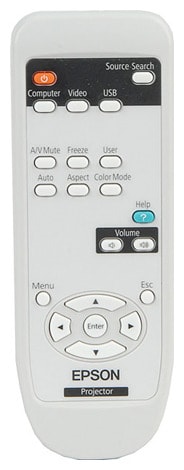
Programming & Flexibility
{{section_header}}{{section.name}}{{/section_header}}
The Optoma GT720's remote control cannot be programmed to work with any other type of device.
Other Connections
{{section_header}}{{section.name}}{{/section_header}}
The Optoma GT720 features an RS-232C connection for advanced users, and an 1/8th-inch audio output for better sound than the tinny built-in speakers.
Placement
{{section_header}}{{section.name}}{{/section_header}}
All the ports are placed on the back, and clearly labeled. That's about as convenient as we can ask for.
Internet & Media Features
Menus & Manual
{{section_header}}{{section.name}}{{/section_header}}
The menus are frustrating to use. We already explained how terrible the remote control is, which certainly contributes to problems with menu interactions, but the menus themselves are annoying. It's never quite clear how to advance or go back a page in the menu tree. Sometimes you hit the enter button, and sometimes you hit the Menu button. Sometimes you hit a button thinking you'll get one result, only to find that yourself directed somewhere else because you couldn't tell what was highlighted.
Fortunately, the instruction manual is more direct. It's certainly not as thorough as a good TV manual, but it gives at least cursory explanations of every button and setting.
Input Ports
{{section_header}}{{section.name}}{{/section_header}}
The Optoma GT720 has an HDMI, VGA, S-Video, and composite AV inputs. There's also an audio output and RS-232C. This should be enough ports for basic AV needs, but it lacks the ports of a high-end projector like a dedicated component AV, DVI input, ethernet, or a second VGA. Of course, there are always workarounds. The projector comes with a component-to-VGA adapter, and you can always buy a cheap DVI-to-HDMI adapter online.
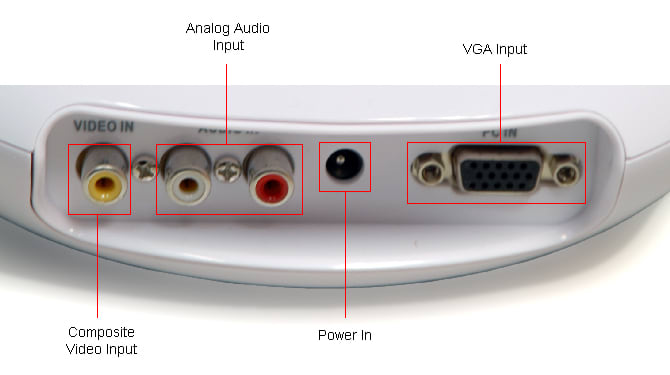
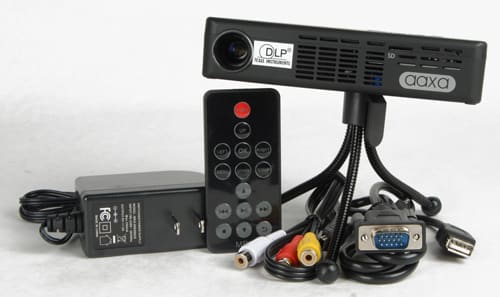
Lots of cables are included
All the ports are listed below, compared with the competition.
Noise
{{section_header}}{{section.name}}{{/section_header}}
The Optoma GT720 is not a particularly noisy. With an ambient room level of 34.8dB, the noise increased to 39.2dB with the projector on and in Bright Lamp mode. If you put the lamp in Standard Mode, the noise decreases only slightly.
{{image_chart title="Noise", attachment="Noise Graph"}}
Heat
{{section_header}}{{section.name}}{{/section_header}}
The Optoma GT720 is quite the little oven. In Bright Lamp mode (recommended), it warmed the air by 63 degrees at the exhaust fan. In Standard Lamp mode, it only warmed the air by 51 degrees, which is still warmer than some similar sized projectors we've reviewed.
{{image_chart title="Heat", attachment="Heat Graph"}}
Power Consumption
{{section_header}}{{section.name}}{{/section_header}}
The Optoma GT720's power requirements vary a little depending on what video mode you've selected, but even at it's brightest it'll only cost about $44.91 per year. Granted, that's a lot more than a large LCD TV or mid-sized plasma, but cheaper than some projectors we've reviewed.
{{image_chart title="Power Consumption (modes)", attachment="Power Consumption Modes Graph"}}
{{image_chart title="Power Consumption (calibrated)", attachment="Power Consumption Comparison Graph"}}
Lamp Life
{{section_header}}{{section.name}}{{/section_header}}
Optoma estimates that the 180 watt P-VIP lamp will run 5000 hours in Standard Lamp mode and 3000 hours in Bright Lamp mode. The latter is recommended for better video performance.
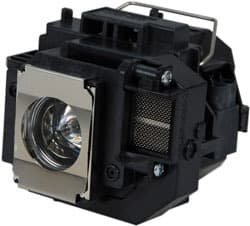
The lamp of the 705HD
Value
{{section_header}}{{section.name}}{{/section_header}}
The Canon LV-8310 costs about the same as the Optoma GT720 and has the same WXGA (1280 x 800) resolution. However, the Optoma posits itself as a "portable gaming" projector. However, most gaming systems are 1080i or 1080p, and the Optoma showed terrible problems with rescaling those resolutions, and it's not really that light. On the other hand, the Canon doesn't support 1080p at all. On the whole, the Optoma GT720 is more flexible for gamers, but the Canon might be the better pick for offices.
Blacks & Whites
{{section_header}}{{section.name}}{{/section_header}}
The Optoma GT720 managed a slightly brighter performance than the Canon LV-8310. However, it suffered from more problems with tunnel contrast, which means that black levels vary widely depending on how much black is on the screen.
{{image_chart title="Contrast", attachment="Contrast Graph"}}
Color
{{section_header}}{{section.name}}{{/section_header}}
The Optoma GT720 displayed more shadow detail, but lost some detail in the highlights. The Canon was smoother throughout the signal range.
Motion
{{section_header}}{{section.name}}{{/section_header}}
The Canon LV-8310 was not quite as smooth in its motion performance as the Optoma GT720, but they both had about the same amount of artifacting.
Viewing Effects
{{section_header}}{{section.name}}{{/section_header}}
The Optoma GT720 has a very short throw distance, and there's no zoom lens to give you a little flexibility. The Canon LV-8310 has a 1.2x zoom and a longer throw.
Connectivity
{{section_header}}{{section.name}}{{/section_header}}
The Canon trumps the Optoma GT720 with a VGA output and ethernet input. The Optoma GT720 has an HDMI, but it's easy to adapt an HDMI input into the DVI port on the Canon.
Value
{{section_header}}{{section.name}}{{/section_header}}
The Optoma HD66 has a native 720p (1280 x 720) resolution, making it ready for HD video straight out of the box. The Optoma GT720 has a hard time rescaling HD video in all its formats, so the HD66 is looking better already. The HD66 is also smaller and lighter, making it more portable than the "portable gaming" GT720. Overall, we'd have to pick the HD66 as the better value.
Blacks & Whites
{{section_header}}{{section.name}}{{/section_header}}
Both Optomas offer great brightness, so you shouldn't have problems in dark to moderately-lit rooms. The Optoma GT720 definitely had more problems with maintaining a consistent black level, but we were pleased overall with both projectors.
{{image_chart title="Contrast", attachment="Contrast Graph"}}
Color
{{section_header}}{{section.name}}{{/section_header}}
The Optoma HD66 showed some unusual results in the color curves test (the red channel peaked early, losing detail in the highlights), while the Optoma GT720 was more normalized. Overall, the Optoma GT720 is the better color performer, provided you put it in Cinema mode.
Motion
{{section_header}}{{section.name}}{{/section_header}}
The Optoma GT720 has smoother motion performance than the HD66, but they have approximately the same amount of artifacting.
Viewing Effects
{{section_header}}{{section.name}}{{/section_header}}
The Optoma GT720 has a short throw and no zoom lens, making it less flexible than the Optoma HD66, which has a longer throw and 1.1x zoom.
Connectivity
{{section_header}}{{section.name}}{{/section_header}}
The Optoma HD66 has a VGA output, which the Optoma GT720 lacks. Otherwise, they are the same.
Value
{{section_header}}{{section.name}}{{/section_header}}
The Epson 705 HD is considerably cheaper than the Optoma GT720, but had bad enough color performance that we just can't recommend it for movies or HD gaming.
Blacks & Whites
{{section_header}}{{section.name}}{{/section_header}}
The Optoma GT720 proved to be a lot brighter than the Epson 705 HD, but suffered from problems with maintaining a consistent black level.
{{image_chart title="Contrast", attachment="Contrast Graph"}}
Color
{{section_header}}{{section.name}}{{/section_header}}
The Epson 705 HD was not a strong color performer. What should have been smooth transitions in color gradients looked like a mess of color banding. It's simply not up to the task required of a decent home theater projector
Motion
{{section_header}}{{section.name}}{{/section_header}}
The Epson 705 HD had more problems producing smooth motion than the Optoma GT720.
Viewing Effects
{{section_header}}{{section.name}}{{/section_header}}
The Optoma GT720 has a very short throw distance and no zoom. The Epson 705 HD has a slightly longer thrown and a zoom lens that makes it a little more flexible.
Connectivity
{{section_header}}{{section.name}}{{/section_header}}
The Epson 705 HD offers two USB ports that allow you to plug in USB storage devices. Otherwise, the AV inputs are the same as what you find on the Optoma GT720.
Conclusion
The Optoma GT720 is not a perfect projector, but it's certainly not a bad projector. In one mode, the brightness is outstanding, but the color performance is awful. In another mode, the color performance is great, but it's not bright enough to see in even a moderately lit room. It claims to be a projector for gamers, but most game systems operate at the 720p, 1080i, or 1080p resolution, none of which the GT720 can rescale to very effectively. Sure, it's technically capable, but we noticed severe Moire patterns and illegible fine text.
The included backpack certainly helps make the Optoma GT720 more portable, but Optoma definitely cheaped out by including only inflated plastic padding – short-term use packing material, essentially – rather than sewing the padding into the bag. Weighing in at 6.5 pounds, we're not sure how often you'll be inclined to lug this around, anyway.
On the whole, it's a decent projector, but if you're serious about gaming and are set on buying a projector rather than a TV, we recommend looking for something with a 720p or 1080p native resolution.
Specs and Ratings
Meet the tester
David Kender oversees content at Reviewed as the Editor in Chief. He served as managing editor and editor in chief of Reviewed's ancestor, CamcorderInfo.com, helping to grow the company from a tiny staff to one of the most influential online review resources. In his time at Reviewed, David has helped to launch over 100 product categories and written too many articles to count.
Checking our work.
Our team is here to help you buy the best stuff and love what you own. Our writers, editors, and experts obsess over the products we cover to make sure you're confident and satisfied. Have a different opinion about something we recommend? Email us and we'll compare notes.
Shoot us an email